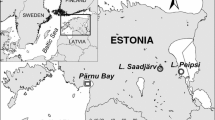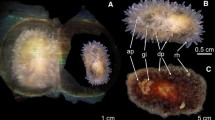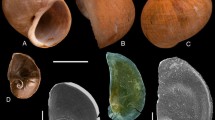Summary
Samples of ovigerous female Ceratoserolis trilobitoides carrying newly spawned (stage A1) eggs in the marsupium were obtained from Borge Bay; Signy Island (South Orkney Islands), the continental shelf near Elephant Island (South Shetland Islands), and two sites in the inner Weddell Sea. The dry mass of a newly spawned egg was greater at the inner Weddell Sea sites even when the larger size of the females from the Weddell Sea and the positive relationship between egg size and female size were taken into account. Larger eggs contained more yolk, and there was a slight but significant tendency for larger eggs to have a lower percentage nitrogen content. Eggs from Ceratoserolis meridionalis were smaller in size than sympatric Ceratoserolis trilobitoides, but of similar composition. The reason for a greater investment per egg by females at higher latitudes is not clear, but it may be related to a slightly longer development period, itself associated with the lower water temperatures in the inner Weddell Sea.
Similar content being viewed by others
References
Bosch I, Pearse JS (1990) Developmental types of shallow water asteroids of McMurdo Sound, Antarctica. Mar Biol 104:41–46
Bosch I, Beauchamp KB, Steele ME, Pearse JS (1987) Development, metamorphosis, and seasonal abundance of embryos and larvae of the Antarctic sea urchin Sterechinus neumayeri. Biol Bull 173:126–135
Brandt A (1988) Antarctic serolidae and cirolanidae (Crustacea: Isopoda): new genera, new species and redescriptions. In: Fricke R (ed) Theses Zoologicae, vol 10. Koeltz Scientific Books, Koenigstein, 143 pp
Cals P (1977) Dérive continentale et spéciation du complex Ceratoserolis nov. gen., Crustacés antarctiques benthiques connus de l'Arc de la Scotia aux îles Kerguelen. CR Acad Sci, Ser D 284:2273–2276
Clarke A (1979) On living in cold water: K-strategies in Antarctic benthos. Mar Biol 55:111–119
Clarke A (1982) Temperature and embryonic development in polar marine invertebrates. Int J Invert Reprod Develop 5:71–82
Clarke A (1987) Temperature, latitude and reproductive effort. Mar Ecol Prog Ser 38:89–99
Clarke A, Skadsheim A, Holmes LJ (1985) Lipid biochemistry and reproductive biology in two species Gammaridae Crustacea, Amphipoda. Mar Biol 88:247–263
Clarke A, Holmes LJ, White MG (1988) The annual cycle of temperature, chlorophyll and major nutrients at Signy Island, South Orkney Islands, 1969–82. Bull Br Antarct Surv 80:65–86
Clarke A, Hopkins CCE, Nilssen EM (1991) Egg size and reproductive output in the deep-water prawn Pandalus borealis. Funct Ecol 5:724–730
Gnaiger E, Bitterlich G (1984) Proximate biochemical composition and calorific content calculated from elemental CHN analysis: a stoichiometric concept. Oecologia 62:289–298
Gorny M, Arntz W, Clarke A, Gore DJ (1992) Reproductive biology of caridean decapods from the Weddell Sea. Polar Biol (in press)
Hadfield MG, Miller SE (1987) On developmental patterns of opisthobranchs. Am Malacol Bull 5:197–214
Hodgson TV (1910) Isopoda. Nat Antarct Exped 1901–1904 5:1–77
Horwood JW (1990) Fecundity and maturity of plaice (Pleuronectes platessa) from Cardigan Bay. J Mar Biol Assoc UK 70:515–529
Lawrence JM, McClintock JB, Guille A (1984) Organic level and caloric content of eggs of brooding asteroids and an echinoid (Echinodermata) from Kerguelen (South Indian Ocean). Int J Invert Reprod Develop 7:249–257
Lima GM, Lutz RA (1990) The relationship of larval shell morphology to mode of development in marine prosobranch gastropods. J Mar Biol Assoc UK 70:611–637
Luxmoore RA (1982) The reproductive biology of some serolid isopods from the Antarctic. Polar Biol 1:3–11
McClintock JB, Pearse JS (1986) Organic and energy content of eggs and juveniles of Antarctic echinoids and asteroids with lecithotrophic development. Comp Biochem Physiol 85A:341–345
McEdward LR, Carson SF (1987) Variation in egg organic content and its relationship with egg size in the starfish Solaster stimpsoni. Mar Ecol Prog Ser 37:159–169
McEdward LR, Chia F-S (1991) Size and energy content of eggs from echinoderms with pelagic lecithotrophic development. J Exp Mar Biol Ecol 147:95–102
McLaren IA, Corkett CJ, Zillioux EJ (1969) Temperature adaptations of copepod eggs from the arctic to the tropics. Biol Bull (Woods Hole, Mass) 137:486–493
Mileikovsky SA (1971) Types of larval development in marine bottom invertebrates, their distribution and ecological signif icance: a re-evaluation. Mar Biol 10:193–213
Monteleone DM, Honde ED (1990) Influence of maternal size on survival and growth of striped bass Morone saxatilis Walbaum eggs and larvae. J Exp Mar Biol Ecol 140:1–11
Murray J (1885) Notes on the reproduction of certain echinoderms from the Southern Ocean Rep Sci Res Voy HMS Challenger 1 (Narrative, Part 1, Chapter X):379–396
Patel B, Crisp DJ (1960) The influence of temperatube on the breeding and moulting activities of some warm-water species of operculate barnacles. J Mar Biol Assoc UK 39:667–680
Pearse JS, Giese AC (1966) The organic constitution of several benthonic invertebrates from McMurdo Sound, Antarctica. Comp Biochem Physiol 18:47–57
Pearse JS, McClintock JB, Bosch I (1991) Reproduction of Antarctic benthic marine invertebrates: tempos, models, and timing. Am Zool 31:65–80
Quattro JM, Weeks SC (1991) Correlations between egg size and egg energetic content within and among biotypes of the genus Poeciliopsis. J Fish Biol 38:331–334
Ross RM, Quetin LB, Kirsch E (1988) Effect of temperature on developmental times and survival of early larval stages of Euphausia superba Dana. J Exp Mar Biol Ecol 121:55–71
Thresher RE (1988) Latitudinal variation in egg sizes of tropical and sub-tropical North Atlantic shore fishes. Environ Biol Fish 21:17–25
Thomson CW (1878) Notice of some pecularities on the mode of propagation of certain echinoderms of the southern seas. J Linn Soc Zool 13:55–79
Thorson G (1936) The larval development, growth and metabolism of Arctic marine bottom invertebrates compared with those of other seas. Meddr Groenl 100:1–155
Thorson G (1950) Reproductive and larval ecology of marine bottom invertebrates. Biol Rev 25:1–45
Turner RL, Lawrence JM (1979) Volume and composition of echinoderm eggs: implications for the use of egg size in life history models. In: Stancyk SE (ed) Reproductive ecology of marine invertebrates. University of South Carolina Press, Columbia, South Carolina, pp 25–40
Wägele J-W (1986) Polymorphism and distribution of Ceratoserolis trilobitoides (Eights, 1833) (Crustacea, Isopoda) in the Weddell Sea and synonymy with C. cornuta (Studer, 1879). Polar Biol 6:127–137
Wägele J-W (1987) On the reproductive biology of Ceratoserolis trilobitoides (Crustacea: Isopoda): latitudinal variation of fecundity and embryonic development. Polar Biol 7:11–24
Willows RI (1987) Intrapopulation variation in the reproductive characteristics of two populations of Ligia oceanica (Crustacea: Oniscidae). J Anim Ecol 56:331–340
Wooton RJ (1979) Energy costs of egg production and environmental determinants of fecundity in teleost fishes. Symp Zool Soc London 44:133–159
Zastrow CE, Houde ED, Saunders EH (1990) Quality of striped bass (Morone saxatilis) eggs in relation to river source and female weight. Rapp P-V Reún Cons Int Explor Mer 191:34–42
Author information
Authors and Affiliations
Additional information
Data presented here were collected during the European Polarstern Study (EPOS) sponsored by the European Science Foundation
Rights and permissions
About this article
Cite this article
Clarke, A., Gore, D.J. Egg size and composition in Ceratoserolis (Crustacea: Isopoda) from the Weddell Sea. Polar Biol 12, 129–134 (1992). https://doi.org/10.1007/BF00239973
Received:
Accepted:
Issue Date:
DOI: https://doi.org/10.1007/BF00239973




